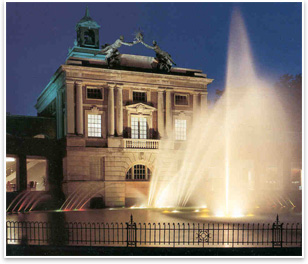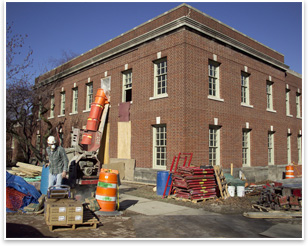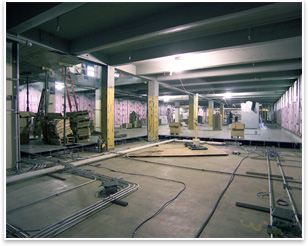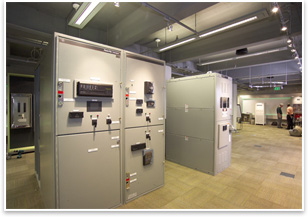GE’s Nela Park: Modern Product Showroom in 18th-Century Garb
by Zach Mortice
Assistant Editor
Summary: GE’s Electric Lighting Institute at Nela Park is a Georgian Revival lighting industry campus that was the nation’s fist ever industrial park. Though many of its former functions have been assumed by other GE facilities, Cleveland’s Nela Park is still the company’s premiere conference and marketing site for its lighting division.
 At various points in its nearly 100-year history, General Electric’s Lighting and Electrical Institute at Nela Park has been a manufacturing site, office space, research site, testing lab, marketing pitch center, and industry training ground. Certainly, not all of these functions are reflected in its stately collegiate Georgian Revival architecture, and some have been spun off to other GE locations across the world. But since the 1920s, industry leaders are still coming to Nela Park to learn about lighting, and this role suits its architecture best. At various points in its nearly 100-year history, General Electric’s Lighting and Electrical Institute at Nela Park has been a manufacturing site, office space, research site, testing lab, marketing pitch center, and industry training ground. Certainly, not all of these functions are reflected in its stately collegiate Georgian Revival architecture, and some have been spun off to other GE locations across the world. But since the 1920s, industry leaders are still coming to Nela Park to learn about lighting, and this role suits its architecture best.
Perched on a hill in an inner-ring Cleveland suburb, the Nela Park campus has much more in common functionally and formally with nearby Case Western Reserve University than it does with the impoverished East Cleveland neighborhood that surrounds it. Its main buildings could be mistaken for the administrative halls of a small Midwestern liberal arts college, with masonry columns, porticos, meandering green space, and tree-lined paths. Its primary building for visitors (The Edison Building) features a Palladian design that embraces a pool and fountain originally used as an auxiliary water supply in case of fire.
 The National Electric Lamp Association The National Electric Lamp Association
New York City architect Frank Wallis designed Nela Park, and about 20 buildings were built from 1911 to 1921. The campus was originally the site of the National Electric Lamp Association (NELA—the acronym that eventually became campus’s name), an association of small electrical product manufacturers that sought to standardized and unite the nascent industry. From the beginning, GE invested heavily in this collective and used its sway to standardize the business around the GE-invented light bulb screw base. In 1911, a U.S. federal court order told the company to dissolve the collective and do business under its own brand. The result was the nation’s first industrial park. Through its history, Nela Park has been an academic think tank for scientists and lighting engineers, and the first practical, mass-produced fluorescent light was invented there. Mary Beth Gotti, manager of the Lighting Institute, says she has a picture of Albert Einstein on the campus. “My dream is to be able to pull examples of [archival materials] and put it on display in a mini museum,” she says.
 Nela Park has been on the National Register of Historic Places since 1975, and every December it hosts a famous Christmas lighting display that features a miniature version of the national Christmas tree in Washington, D.C. Nela Park has been on the National Register of Historic Places since 1975, and every December it hosts a famous Christmas lighting display that features a miniature version of the national Christmas tree in Washington, D.C.
The showroom
For a former lighting industry center of learning made by one of the 20th century’s great industrial heralds of progress, Wallis’s designs weren’t particularly forward-looking. Their staid, yet elegant Revival forms don’t hint at the world-changing innovation and invention that became common there. A better match of form and function exists today, now that Nela Park is GE Lighting’s primary lighting marketing and conference site. The last Nela Park factory was converted to offices in the 1980s, and no research goes on there, though product testing still happens at the site, according to Gotti.
 Today, Nela Park’s role as an exhibit hall for the wonders of GE lighting has it emitting the chirps and whirrs of the modern marketing lab at the flip of a switch. The Edison Building is composed of a series of small marketing auditoriums that are equipped to show potential customers and media outlets how GE products function in different environments when used on different objects. The QVC-esque Merchandising Center focuses on retail lighting. There, visitors sit in front of a curtained stage, flanked by shelves of products. A false ceiling brings different lighting arrays down, and lighting bays in front of the stage illuminate clothing, food items, domestic home products, and jewelry. The Commercial and Industrial Lighting Center shines different types of light from moveable ceiling arrays onto a swivel-mounted, full-scale office cubicle environment and a concrete-floored warehouse. Today, Nela Park’s role as an exhibit hall for the wonders of GE lighting has it emitting the chirps and whirrs of the modern marketing lab at the flip of a switch. The Edison Building is composed of a series of small marketing auditoriums that are equipped to show potential customers and media outlets how GE products function in different environments when used on different objects. The QVC-esque Merchandising Center focuses on retail lighting. There, visitors sit in front of a curtained stage, flanked by shelves of products. A false ceiling brings different lighting arrays down, and lighting bays in front of the stage illuminate clothing, food items, domestic home products, and jewelry. The Commercial and Industrial Lighting Center shines different types of light from moveable ceiling arrays onto a swivel-mounted, full-scale office cubicle environment and a concrete-floored warehouse.
 The Center for Electrical Solutions is GE’s showroom for its electrical distribution products. This room is designed in a raw industrial, hi-tech vernacular. Steel and gray predominate, except for the large white, blue, and green colored LED lights that surround a television that plays GE ads. A steel mesh curtain pulls back to reveal the company’s wares. The raised-floor construction is meant to accommodate ductwork that keeps the unfinished concrete ceiling bare. The floor is reinforced to support the massive distribution units that sit there—technologically astute gray boxes in a technologically astute and sleekly designed gray box of a room—albeit, one surrounded by an architect’s vision of the past. The Center for Electrical Solutions is GE’s showroom for its electrical distribution products. This room is designed in a raw industrial, hi-tech vernacular. Steel and gray predominate, except for the large white, blue, and green colored LED lights that surround a television that plays GE ads. A steel mesh curtain pulls back to reveal the company’s wares. The raised-floor construction is meant to accommodate ductwork that keeps the unfinished concrete ceiling bare. The floor is reinforced to support the massive distribution units that sit there—technologically astute gray boxes in a technologically astute and sleekly designed gray box of a room—albeit, one surrounded by an architect’s vision of the past.
|



 The National Electric Lamp Association
The National Electric Lamp Association Nela Park has been on the National Register of Historic Places since 1975, and every December it hosts a famous Christmas lighting display that features a miniature version of the national Christmas tree in Washington, D.C.
Nela Park has been on the National Register of Historic Places since 1975, and every December it hosts a famous Christmas lighting display that features a miniature version of the national Christmas tree in Washington, D.C. Today, Nela Park’s role as an exhibit hall for the wonders of GE lighting has it emitting the chirps and whirrs of the modern marketing lab at the flip of a switch. The Edison Building is composed of a series of small marketing auditoriums that are equipped to show potential customers and media outlets how GE products function in different environments when used on different objects. The QVC-esque Merchandising Center focuses on retail lighting. There, visitors sit in front of a curtained stage, flanked by shelves of products. A false ceiling brings different lighting arrays down, and lighting bays in front of the stage illuminate clothing, food items, domestic home products, and jewelry. The Commercial and Industrial Lighting Center shines different types of light from moveable ceiling arrays onto a swivel-mounted, full-scale office cubicle environment and a concrete-floored warehouse.
Today, Nela Park’s role as an exhibit hall for the wonders of GE lighting has it emitting the chirps and whirrs of the modern marketing lab at the flip of a switch. The Edison Building is composed of a series of small marketing auditoriums that are equipped to show potential customers and media outlets how GE products function in different environments when used on different objects. The QVC-esque Merchandising Center focuses on retail lighting. There, visitors sit in front of a curtained stage, flanked by shelves of products. A false ceiling brings different lighting arrays down, and lighting bays in front of the stage illuminate clothing, food items, domestic home products, and jewelry. The Commercial and Industrial Lighting Center shines different types of light from moveable ceiling arrays onto a swivel-mounted, full-scale office cubicle environment and a concrete-floored warehouse. The Center for Electrical Solutions is GE’s showroom for its electrical distribution products. This room is designed in a raw industrial, hi-tech vernacular. Steel and gray predominate, except for the large white, blue, and green colored LED lights that surround a television that plays GE ads. A steel mesh curtain pulls back to reveal the company’s wares. The raised-floor construction is meant to accommodate ductwork that keeps the unfinished concrete ceiling bare. The floor is reinforced to support the massive distribution units that sit there—technologically astute gray boxes in a technologically astute and sleekly designed gray box of a room—albeit, one surrounded by an architect’s vision of the past.
The Center for Electrical Solutions is GE’s showroom for its electrical distribution products. This room is designed in a raw industrial, hi-tech vernacular. Steel and gray predominate, except for the large white, blue, and green colored LED lights that surround a television that plays GE ads. A steel mesh curtain pulls back to reveal the company’s wares. The raised-floor construction is meant to accommodate ductwork that keeps the unfinished concrete ceiling bare. The floor is reinforced to support the massive distribution units that sit there—technologically astute gray boxes in a technologically astute and sleekly designed gray box of a room—albeit, one surrounded by an architect’s vision of the past.